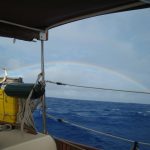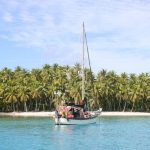May 2010
 |
| Rainbow at sea |
Well, we are finally in Pago Pago, American Samoa. It turned out to be a bit of a challenge. As they say…”the best laid plans…” and all that.
Try and plan as we did we could not get to the Southern Cook Islands of Aitutaki, Raratonga and Niue.
The area between Bora Bora and Pago Pago is known as “the Dangerous Middle” and not without good reason. The route from the Galapagos to Bora Bora is known as “the Milk Run” because the wind and weather along this route is usually extremely stable and predictable. Very little variation—just sit back and enjoy the ride.
But once you leave Bora Bora all of that changes. A LOT can and often DOES happen. The wisdom has always been if you want less wind plan a track to the North Rose Island, Suwarrow or Palmerston. If you want more wind head South toward Aitutaki,Raratonga and Niue. If you are lucky, the winds will not be “that bad.” Well, we did not get lucky. We had this fabulous route planned to take in ALL of the islands both North and South. We had plenty of time with no deadlines or obligations. But, the weather just did not co-operate.
The winds along the northern route were nice and gentle but each time we made our tack South for one of the islands, the wind and seas became wild. We would have toughed it out but the Southern Cooks do not have good sheltered harbours and in these conditions everyone there either has to hang on for dear life or “bail out” by going out to sea until the weather passes. This is what was happening down there. We spoke to friends by radio and they were indeed “in the thick of it” and it would serve no purpose whatever to travel on only to be run out of the harbour again. So, reluctantly we tacked back to the North. Our destination, Suwarrow (Suvarov), often described as “the most romantic island in the world!”
Suwarrow (Latitude 13 Deg. 14.9 S Longitude 163 Degrees 06.4 West)is a place of real South Seas Romance, a dot on a chart so small as to be almost invisible, a grain of pepper out in the middle of the vast Pacific. Years and yars ago I would read the stories of all the ocean sailing pioneers and Suwarrow(Suvarov) figured prominently in their tales. It was a place we had always fanticized about but never dreamed we would ever go there.
 |
| Entracte off suwarrow |
Suwarrow is known from Tom Neal’s delightful book “An Island to One’s Self.” It was here that for 16 years, he chose to live the life of a hermit, just him, the fish and the birds. Tom is now gone and the island is a national park administered by New Zealand but we were so early in the season that the island was indeed deserted.
Suwarrow lived up to it’s reputation and our expectation as an island of romance. It was well worth everything it took to get there. But alas, it seemed prudent to move on while the weather was good. All of these islands are fine and safe as long as the wind is from the normal direction and strength but should the wind shift and get stronger, what was before a safe and secure anchorage is now a death trap with Coral Reefs just waiting to claim your vessel and possibly your life. To have a wind shift and go on a reef out here would be certain disaster. And this happens more often than one would imagine. Constant vigilance is the key to survival. There is NO ONE to help you.
We remained on Suwarrow for a week eventually meeting Pete on French Kiss and Domenique and Serge on ———-.
Our passage from Suwarrow to Pago Pago was a bit anxious, not because of the weather or sailing conditions but because of its reputation—It’s filthy, the stench from the fish packing plants is horrible 24/7, the Samoans are so unfriendly, it’s unsafe——these stories were legion throughout the cruising world so we were ready for anything. Also, as if to emphasize our reasons for leaving Suwarrow we tuned into the Pacific Seafarer’s net every night to keep up with the saga of Domenic who was high and dry on a reef at Rose island—150 miles South of Pago Pago. He went into the atol and all went well until he tried to leave—his engine quite and the current carried him onto the reef. No one could help him free his boat because the conditions were far too rugged and would put anyone who tried to help at severe risk. Domenic tried to maintain a positive attitude, fish, keep his boat together and stay alive until the next full moon would hopefully provide a high enough tide that he might get free. He remained on that reef for an entire month before he finally got free and limped into Pago pago with only a damaged rudder. he was very, very lucky to have survived.
The main reason we were calling at Pago was because of the ease of having things shipped from the US. They came by air at US prices and it was the only real chance to replace equipment at US prices. We needed to replace our battery charger which had been destroyed by lightning in Costa Rica and also we wanted to install some new solar panels. These would have far too costly to replace in French Polynesia or to have them shipped in at overseas rates.
As we entered PagoPago harbour we looked around anxiously, we smelled, we sniffed—at the first sign of a horrible stench—we would turn around and keep moving. And then…….NOTHING HAPPENED!!!! The anchor went down amidst friendly greetings of three Samoan war canoes that were racing through the harbour. Customs was a breeze. The Samoans were extremely friendly,there was no smell at all and did not get killed once!
That afternoon Pete on French Kiss anchored next to us and we proceeded to explore American Samoa, retrieve our mail and packages that we had ordered.
Samoa while not antiseptically clean was not the horror we were led to believe. They were still cleaning up after their experience with last years tsunami. Barbarella anchored just behind us was in the harbour and on board when the tsunami struck. It happened so quickly that they could not get off the boat in time and had to remain on board throughout the entire event. His photos and video were stunning. An entire year later they were still not recovered and repaired to the point that they could depart.
Our days in Pago were delightfully spent in receiving and installing our new gear. Pete ordered a new water maker, our new solar panels worked beautifully. Now all we needed was two new batteries.
We had been suffering from weakening batteries for some time but unfortunately, batteries in French Polynesia are outrageously expensive and we were just hanging on with what we had but our batteries were in tough shape. There seemed to be nothing we could do. Because batteries are considered hazmat–they would have to come by ship from either the US or New Zealand. Neither of these choices were practical from either a time or cost standpoint.
Mr John to the rescue. He came on the radio one evening while we were still in Raiatea and said that he had located two batteries for us in NZ and would carry them on board Mr John until we rendezvoused in Western Samoa. We were now only 150 miles from our rendezvous with John, Paula and our new batteries. BUT once again, “the best laid plans…”
Mr John was having a tough time of it coming from New Zealand. They had horrific head winds and it was doubtful that they would be able to make it to Samoa. At best they just “might” be able to lay Niuatoputapu in Tonga. Each night we would speak by radio and update our plans.
On September 12 Entr’acte finally set sail for Tonga. As much as we wanted to visit Western Samoa we did not want to give up so much windward advantage. To sail from Apia to Tonga would put us 15 degrees farther downwind of our goal.
Our Pacific passages were consistent in one respect, the first two hours of every passage were a horror of wind, wave and motion. In every case we thought that perhaps we should go back into the harbour until things improved, which of course they would not have done so. The harbours were calm and protected by a barrier reef. Outside the reef the water relatively shallow close to shore and the waves would heap up causing a very uncomfortable situation. Once well off soundings in deep water the waves settled down, became more regular and we could finally relax and enjoy the passage. But each time it took some getting used to.
As we left Pago Pago Harbour I had severe misgivings about that choice, surely it could not be that bad. Perhaps we should just go to Apia and take our chances but an hour into the trip we agreed that we had made the right choice. As it was we were hard on a 15 knot breeze and we would be extremely lucky to lay Tonga from here. We were indeed happy with our choice.
Next stop, Tonga.
Ellen and Ed